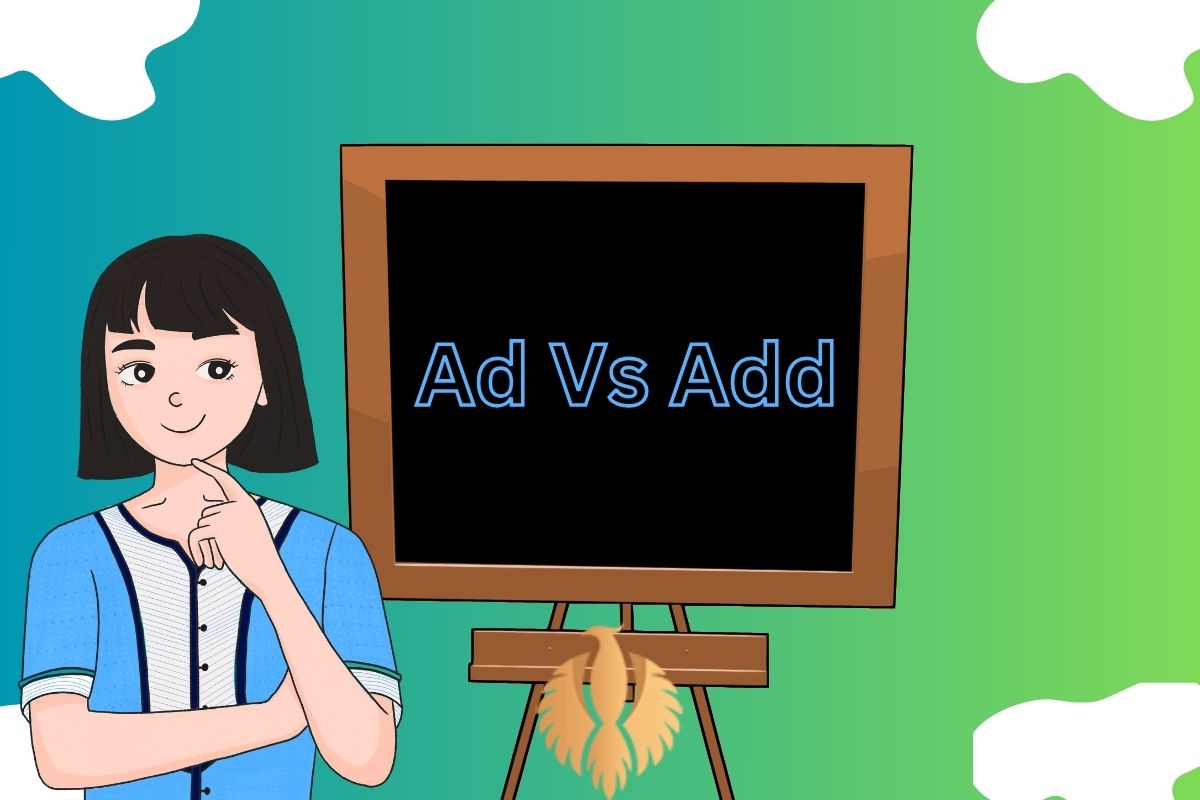The distinction between “add” and “ad” lies in their meanings, applications, and significance within various contexts.
While “add” is a verb primarily associated with mathematical operations and the act of inclusion, “ad” is an abbreviation for advertisement, often referring to promotional content in marketing.
Understanding the nuances of these terms is essential for effective communication and accurate expression.
Firstly, “add” is a versatile verb commonly used in mathematical contexts. Its primary meaning is to combine or unite elements to increase a total.
For instance, when solving mathematical problems, one frequently encounters the need to add numbers or quantities together.
This operation is fundamental to arithmetic and is employed in various fields beyond mathematics, such as accounting, science, and daily life.
“Addition” is the noun form of “add,” encapsulating the process of combining elements.
On the other hand, “ad” is a shortened form of the word “advertisement.” Advertisements play a crucial role in modern society, serving as a means for businesses and individuals to promote products, services, or ideas.
Advertisements utilize various mediums, including print, digital, audio, and visual platforms, to reach a target audience. Effectively designed ads aim to capture attention, convey a message, and ultimately influence consumer behavior.
The success of an ad often hinges on its creativity, relevance, and ability to resonate with the intended audience.
Furthermore, the impact of “add” and “ad” extends beyond their literal meanings. In a broader sense, “add” embodies the concept of augmentation, emphasizing growth and enhancement.
This can apply not only to numerical values but also to ideas, experiences, and relationships. Conversely, “ad” reflects the persuasive power of communication, encapsulating the art of influencing perceptions and decisions.
In the digital age, the boundaries between these terms can blur, particularly with the rise of online advertising.
The internet has become a vast landscape for ads, ranging from sponsored content on social media platforms to targeted advertisements in search engine results.
As technology continues to evolve, the dynamics of how individuals encounter and interact with ads are constantly changing.
While “add” and “ad” may seem like simple terms, their implications and applications are diverse.
“Add” is a fundamental verb tied to mathematical operations and the act of combining elements, fostering growth and augmentation.
On the other hand, “ad” is a condensed form of “advertisement,” representing the dynamic field of marketing and the art of influencing through communication.
Both play integral roles in our daily lives, contributing to our understanding of numbers and our exposure to persuasive messages in the vast landscape of advertising.
What is the difference between add and ad ?
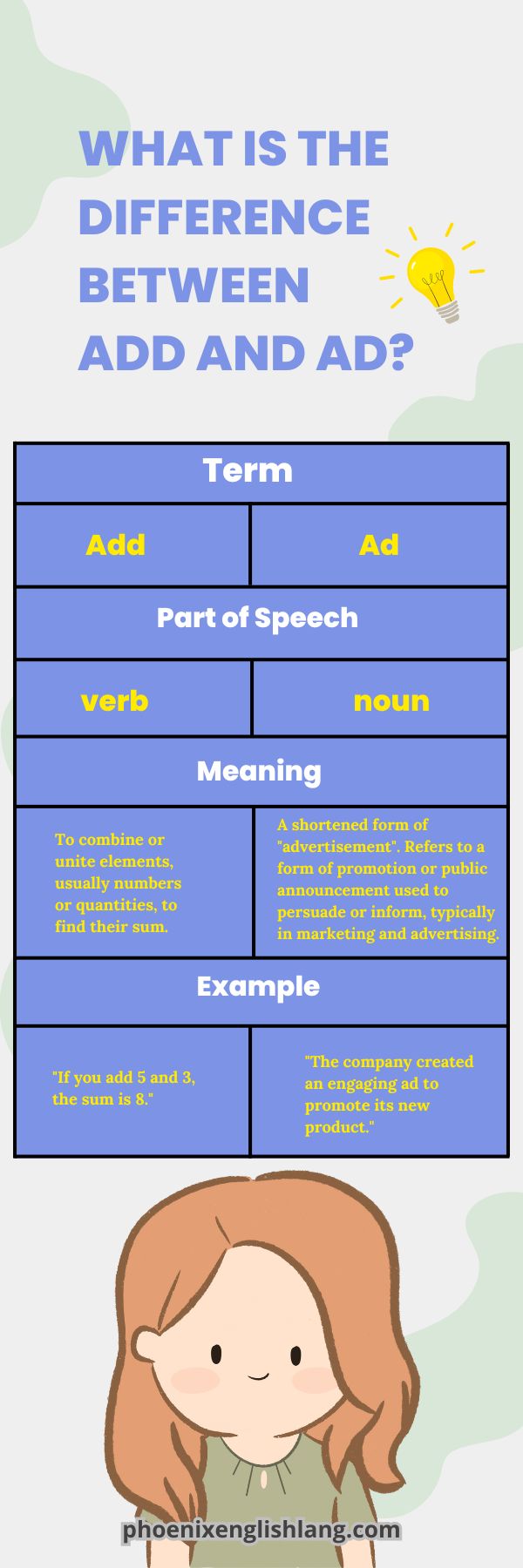
The main difference between “add” and “ad” lies in their meanings and usage:
| 1. Add: |
| – Part of Speech:Verb |
| – Meaning: To combine or unite elements, usually numbers or quantities, to find their sum. |
| – Example:If you add 5 and 3, the sum is 8. |
| 2. Ad: |
| – Part of Speech:Noun (shortened form of “advertisement”) |
| – Meaning: A form of promotion or public announcement used to persuade or inform, typically in marketing and advertising. |
| – Example:The company created an engaging ad to promote its new product. |
We can say that, “add” is a verb used in mathematical contexts to indicate the process of combining numbers or quantities, while “ad” is a noun, short for “advertisement,” referring to a promotional message or announcement used in marketing and communication.
You might also enjoy: Sale Vs Sell: Differences + Examples + Usage [2024]
What is the meaning of add ?

When I think about the word “add,” it suggests a variety of contexts and meanings. At its core, to add means to combine or join, often to increase the total amount or number of something.
This concept is fundamental in mathematics, where adding numbers together forms the basis of arithmetic. However, the idea of adding extends far beyond just numbers.
In everyday life, adding can refer to incorporating new elements into a situation or enhancing something that already exists. For example, when I cook, I might add spices to a dish to enhance its flavor.
This simple act of adding transforms the dish, making it more complex and enjoyable. Similarly, in social situations, adding a new person to a group can change the dynamics and bring fresh perspectives.
Adding also has a significant role in technology and digital spaces. When I think about software development, adding new features to an application can improve its functionality and user experience.
This process of addition is crucial for innovation and keeping up with user needs. In the realm of social media, adding friends or followers expands one’s network, creating more opportunities for interaction and engagement.
Moreover, the concept of adding can be seen in personal growth and self-improvement. When I add new skills or knowledge to my repertoire, I become more capable and versatile.
This continuous process of addition helps me adapt to changing circumstances and achieve my goals. It’s a reminder that growth often comes from accumulating experiences and learning from them.
In a more abstract sense, adding can also mean contributing to something larger than oneself. For instance, when I volunteer my time or resources to a cause, I am adding value to the community and making a positive impact.
This type of addition is fulfilling and reinforces the idea that small contributions can collectively lead to significant change.
The word “add” also carries a sense of inclusivity. When I add someone to a conversation or a project, I am inviting them to participate and share their ideas. This act of inclusion fosters collaboration and diversity, which are essential for creativity and problem-solving.
It reminds me that adding different perspectives can lead to more comprehensive and innovative solutions.
In summary, the meaning of “add” is multifaceted and extends beyond its mathematical roots. It encompasses the idea of combining, enhancing, and contributing in various aspects of life.
Whether it’s adding ingredients to a recipe, features to a software application, skills to one’s personal toolkit, or value to a community, the act of adding is integral to growth and improvement.
It highlights the importance of inclusion, collaboration, and continuous learning. So, whenever I think about adding, I am reminded of the potential for positive change and the endless possibilities that come with it.
What is the meaning of ad ?
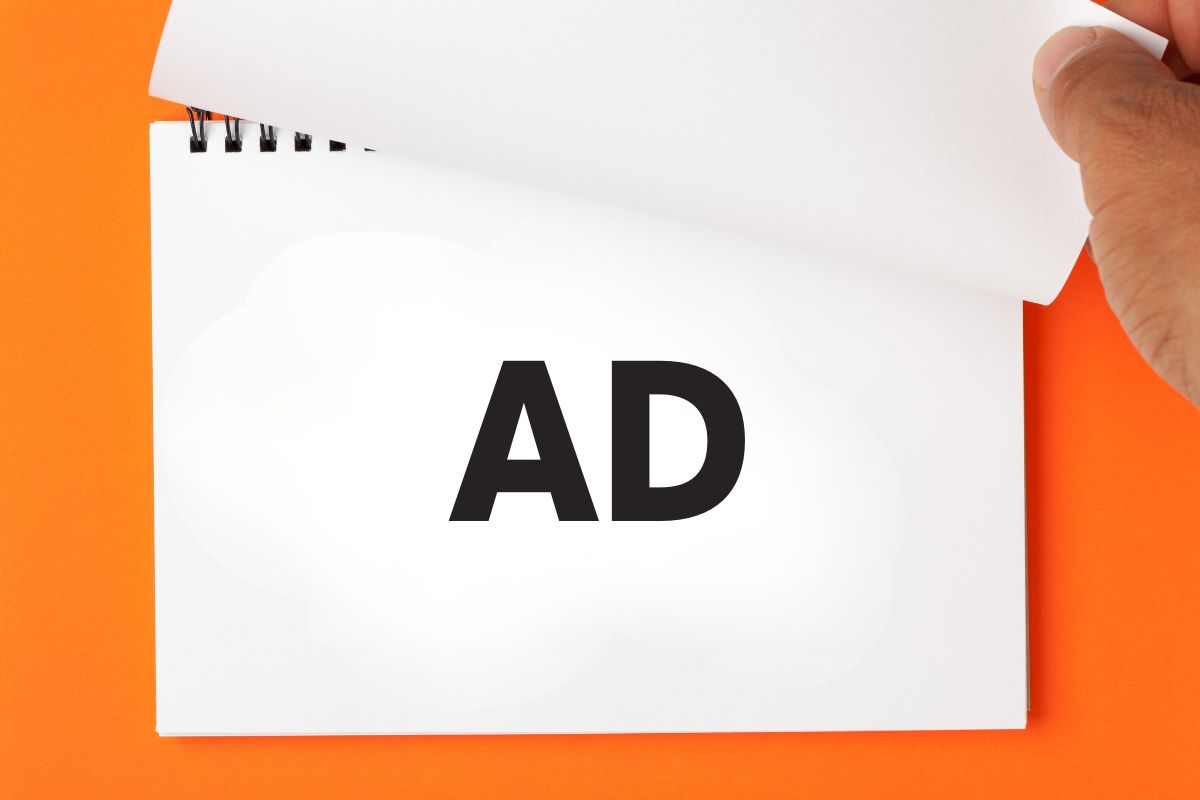
Advertisement (Ad)
In the realm of marketing, “ad” is shorthand for “advertisement.” Advertisements are crafted messages designed to promote products, services, or events. They appear in numerous formats, such as print (newspapers, magazines), broadcast (TV, radio), and digital (websites, social media).
The primary objective of an ad is to capture attention and persuade the audience to take a specific action, like making a purchase or attending an event.
Anno Domini (AD)
“AD” also stands for “Anno Domini,” a Latin term meaning “in the year of our Lord.” This designation is used in the Gregorian calendar to mark years following the birth of Jesus Christ.
Introduced by Pope Gregory XIII in 1582, the Gregorian calendar is the most widely used calendar system today. “AD” helps differentiate years in the current era from those before Christ’s birth, which are labeled “BC” (Before Christ).
Prefix and Suffix
The term “ad” can function as both a prefix and a suffix in English. As a prefix, “ad-” often implies motion or direction toward something, as seen in words like “advance” (move forward) or “adjoin” (to be next to).
It can also suggest addition or increase, as in “add” (to include more) or “adopt” (to take up or start using something).
As a suffix, “ad” appears in various contexts, particularly in forming nouns. For instance, in classical mythology, it is used in names like “naiad” (a type of water nymph) and “dryad” (a tree nymph).
It also appears in terms like “myriad” (a countless or extremely great number) and “triad” (a group of three).
Historical and Cultural Significance
The use of “AD” in dating has significant historical and cultural implications. The system was introduced by a monk named Dionysius Exiguus in the 6th century. He aimed to create a calendar system based on the birth of Jesus Christ, which he considered a pivotal event in history.
This system gradually replaced other dating methods and became widely accepted in Europe during the Middle Ages.
Modern Usage
In contemporary times, “AD” and “BC” have been supplemented by “CE” (Common Era) and “BCE” (Before Common Era) to provide a non-religious alternative.
These terms are especially prevalent in academic and scientific contexts. “CE” corresponds to “AD,” and “BCE” corresponds to “BC,” offering a more inclusive way of referencing dates without religious connotations.
Application add and ad
It seems there might be a slight confusion in your request. If you are referring to the term “add” in the context of software or technology, it commonly refers to the action of including or incorporating something new into an existing system or program.
For example, “to add a feature” in a software application means to integrate or introduce a new functionality to enhance the capabilities of the application.
If you have a specific context or question related to the application of “add,” please provide more details so I can assist you more effectively.
If you’re referring to the term “add” in the context of applications, it could mean different things based on the specific domain. Here are a couple of interpretations:
1. Software Development
– In software development, “add” often refers to the act of incorporating new features, functionalities, or components into an existing application. Programmers may “add” code to enhance or extend the capabilities of the software.
2. User Interface (UI)
– In user interfaces, “add” is commonly associated with inserting new items or data. For instance, you might “add” a new contact to your address book, “add” an event to your calendar, or “add” a new task to a to-do list within an application.
If you have a specific context or application in mind, please provide more details, and I’ll do my best to assist you.
If you’re referring to “application ad,” it could be interpreted in a couple of ways depending on the context:
3. Advertisement within an Application
– In this context, “application ad” could refer to advertisements that appear within a mobile app, software program, or online platform. These ads are often integrated to generate revenue for the app developers or platform owners.
4. Application for Advertising
– Alternatively, “application ad” could mean the process of applying or submitting an advertisement. This might involve creating and submitting content for display through various advertising channels, such as online platforms or traditional media.
If you have a specific context or question related to “application ad,” please provide more details, and I’ll be happy to assist further.
You might also enjoy: Months or Month;s vs Months – Differences + Examples [2024]
What type of word is add ?
The word “add” is a verb. Specifically, it is a transitive verb when used with an object (e.g., “add the numbers”) and an intransitive verb when used without an object (e.g., “let’s add”). As a verb, “add” is associated with mathematical operations, where it signifies the combining or uniting of numbers or quantities to find their sum. Additionally, “add” can be used more broadly to describe the action of including or incorporating something into an existing system or structure.
What type of word is ad ?
The word “ad” is a noun. It is an abbreviation for “advertisement.” As a noun, “ad” refers to a form of communication or announcement, typically paid, that is used to promote or publicize a product, service, or idea. Ads are commonly found in various media such as print, digital platforms, television, radio, or outdoor displays, and they aim to capture attention and influence the audience to take a particular action, such as making a purchase or engaging with a brand.
When can I use add in a sentences?
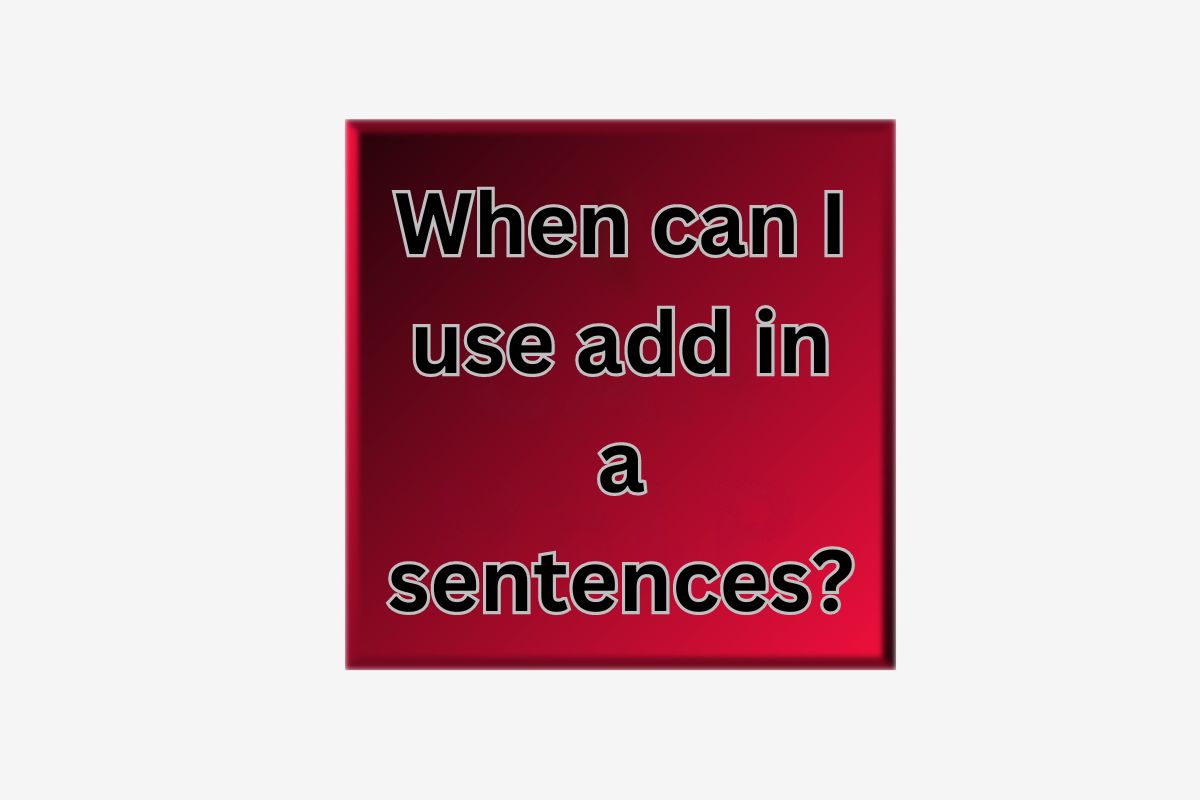
You can use “add” in a sentence in various contexts where the action of combining or including elements is applicable. Here are examples in different situations:
| 1. Mathematical Context: |
| – “Let’s add 7 and 4 to get 11.” |
| – “If you add the lengths of the sides, you’ll find the perimeter.” |
| 2. Cooking or Ingredients: |
| – “I’ll add salt and pepper to enhance the flavor.” |
| – “Don’t forget to add chopped onions to the recipe.” |
| 3. General Context: |
| – “I want to add a personal touch to the gift.” |
| – “We can add more information to make the report comprehensive.” |
| 4. Technology: |
| – “The developer plans to add a new feature to the app.” |
| – “You can easily add contacts to your address book.” |
| 5. Collaborative Efforts: |
| – “Let’s add our strengths to achieve success together.” |
| – “Every contribution will add value to the project.” |
In essence, “add” is used when you want to express the act of bringing things together or combining them to create a unified whole.
You might also enjoy: Performed Vs Preformed: Which One Is Correct? + Examples [2024]
When can I use ad in a sentences ?
You can use “ad” in a sentence when referring to an advertisement. Here are examples in different contexts:
1. Media and Marketing
– “I saw an interesting ad for a new product on TV.”
– “The company launched a creative ad campaign to promote their services.”
2. Online Platforms
– “Pop-up ads can be annoying while browsing the internet.”
– “Social media platforms often display targeted ads based on user preferences.”
3. Print Media
– “Magazines are filled with colorful ads for various products.”
– “Newspapers typically have classified ads for job postings.”
4. Business and Promotion
– “They invested a significant budget in online ads to reach a wider audience.”
– “Creating a catchy ad is crucial for attracting customers.”
Remember, “ad” is a noun representing an advertisement or a form of communication used for promotional purposes.
Is add an abbreviation for advertisement?
No, “add” is not an abbreviation for advertisement. “Add” is typically short for addition or adding. “Ad” is the abbreviation for advertisement.
Can I still use ad?
Certainly, you can use ads for various purposes like promoting products, services, or events. If you have specific questions or need guidance on a particular aspect of advertising, feel free to ask!
Why do we not use AD anymore?
If you’re referring to Microsoft Active Directory (AD), it’s still widely used for managing network resources and user accounts in many organizations. However, there might be evolving technologies or alternative solutions emerging.
How are the meanings of “add” and “ad” different from each other?
The meanings of “add” and “ad” are different from each other in that “add” is a verb that means to join or combine things together, while “ad” is a noun or abbreviation for advertisement, which is a public notice or announcement promoting a product, service, or event. “Add” is related to the action of combining, while “ad” is related to marketing and promotion.
Are there any other meanings or contexts in which “ad” can be used besides as an abbreviation for advertisement?
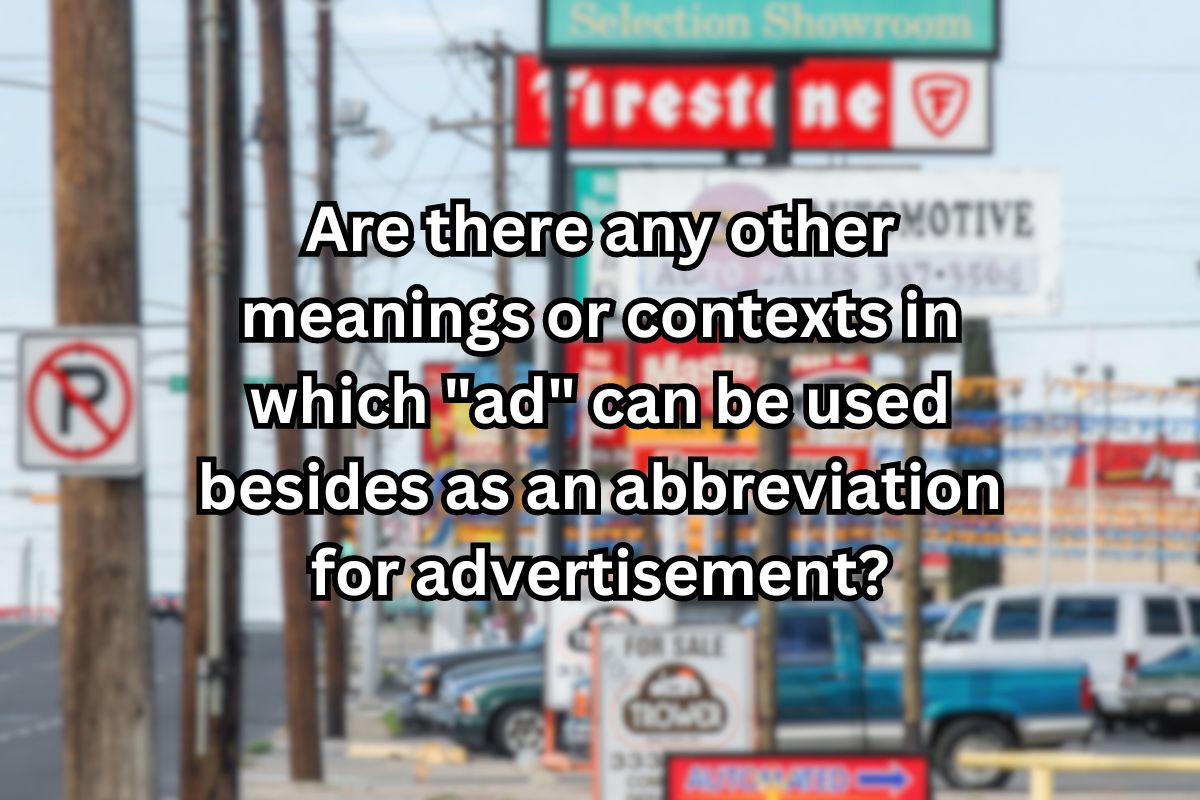
Yes, “ad” can also be used as a short form for “analog-to-digital,” as in “ad converter” or “ad agency” which refers to an advertising agency. Additionally, “ad” can also be used as a prefix in some words, such as “ad hoc” meaning for a specific purpose, or “ad hominem” meaning directed against a person rather than the position they are maintaining.
Are there any other meanings or contexts in which “ad” is used that were not mentioned?
Another context in which “ad” is used is as an abbreviation for “assistant director” in the context of film or theater production. An assistant director helps the director with various tasks related to the production, such as coordinating the cast and crew, managing the schedule, and ensuring that the production runs smoothly. This usage of “ad” is common in the entertainment industry.
Is “ad” used in any other abbreviations or acronyms in the entertainment industry?
Yes, “ad” is also commonly used as an abbreviation for “audio description” in the entertainment industry. Audio description is a service for people with visual impairments, where a narrator provides a spoken description of visual elements during pauses in dialogue, making visual media such as films, television programs, and live performances more accessible to individuals with blindness or low vision.
What countries don t use AD?
Countries that do not use the AD (Anno Domini) dating system include:
- Islamic countries that use the Islamic calendar for dating events.
- Countries that follow other traditional calendars, such as the Chinese calendar or the Hebrew calendar.
These countries may use different dating systems or calendars for their historical and cultural events.
Why don’t we like ads?
There are several reasons why people may not like advertisements (ads):
- Intrusiveness: Ads can be intrusive and disrupt the user’s browsing experience or viewing content.
- Overload: Constant exposure to ads can lead to ad overload, where individuals feel overwhelmed by the sheer volume of advertisements.
- Manipulation: Ads are designed to persuade and influence consumers to buy products or services, which some people may find manipulative.
- Irrelevance: Ads that are not relevant to the individual’s interests or needs may be seen as annoying and a waste of time.
- Privacy concerns: Some people are concerned about the collection of personal data for targeted advertising purposes, leading to privacy issues.
Overall, the dislike for ads varies from person to person based on their individual preferences, experiences, and perceptions of advertising.
Why are so many ads sexualized?
There are several reasons why many ads are sexualized:
- Attention-grabbing: Sexual content in ads is often used to grab the viewer’s attention and make the advertisement more memorable.
- Emotional appeal: Sexual imagery can evoke strong emotions and desires, which marketers may use to create a connection with the audience and drive engagement.
- Persuasion: Sexuality is a powerful motivator, and advertisers may use sexualized content to persuade consumers to buy products or services.
- Taboo and controversy: Sexually suggestive content can create controversy and generate buzz around the advertisement, attracting more attention to the brand.
- Cultural influences: In some cultures, sexual imagery is more accepted and may be used more frequently in advertising to appeal to societal norms and values.
However, it’s important to note that the use of sexualized content in ads can also be controversial and may lead to backlash from consumers who find it inappropriate or offensive. Marketers should consider the ethical implications of using sexual imagery in advertisements and ensure that it aligns with their brand values and target audience.
Who invented ads?
The concept of advertising has been around for centuries, but the modern advertising industry as we know it today has evolved over time. While it is difficult to pinpoint a single individual who “invented” ads, there are key figures and milestones in the history of advertising that have shaped the industry:
- Ancient civilizations: Advertising has roots in ancient civilizations where merchants used symbols and signs to promote their goods and services. Examples include advertisements found in ancient Egyptian papyrus scrolls and Roman gladiatorial games.
- Print advertising: The invention of the printing press in the 15th century enabled the mass production of printed materials, leading to the rise of printed advertisements in newspapers, posters, and handbills.
- Industrial Revolution: The Industrial Revolution in the 18th and 19th centuries marked the rapid growth of consumer goods and the need for advertising to promote products to a wider audience.
- Madison Avenue: In the early 20th century, the advertising industry began to take shape in the United States, with agencies like J. Walter Thompson and Ogilvy & Mather pioneering modern advertising techniques.
While there isn’t a single inventor of advertising, the evolution of advertising can be attributed to the contributions of many individuals, companies, and technological advancements over time.

Hi, welcome to my blog! My name is Omid and I am thrilled to have you here! I am an English language teacher with 12 years of experience and hold multiple international certifications (TESOL, IELTS, TOEFL, PTE, CELTA). Additionally, I hold a PhD in Applied Linguistics with a specialization in Teaching English as a Second Language (TESL), which fuels my passion for teaching English and assisting others in mastering the language. To me, nothing is more rewarding than helping individuals enhance their English language abilities through various methods. So, let’s embark on this journey of learning English together.

